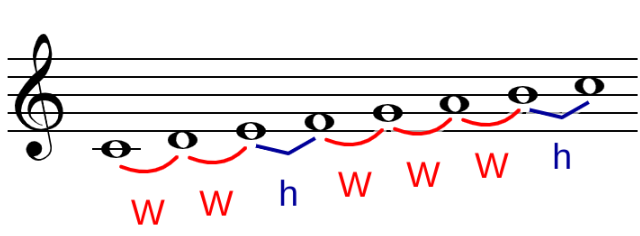Pitch & Fundamentals
Pitch
Pitches are specific vibration frequencies. They are distinguished by a letter, number, and an accidental:
- The letter specify what the note is (A, B, C, D, E, F, or G).
- The accidental specifies the pitch of the note (sharp, flat, or natural). Though, if the note is natural, the accidental is usually omitted.
- The number designates the octave.
- This number, known as the pitch class, is determined based on which octave of C is below the note in question.
- For example: all notes that fall between C4 and C5 will be labelled with a 4, as they are above C4 and below C5. These notes are: C4, C#/Db4, D4, D#/Eb4, E4, F4, F#/Gb4, G4, G#/Ab4, A4, and B4.
- Once C5 is reached, however, all following notes have a 5, until they reach C6, then on and on.
The octaves of C, labelled, can be seen below:

Putting these three classifications together can allow a specific note to be referred to on the grand staff. For example, this note:

This note is a C note with a # pitch following the fifth C, C5. This means it is a C#5 note.
Intervals
Intervals---the space between two notes. Measured in steps (moving up by two notes, ex: C to D) or in half steps (moving up one note, ex: C to C#).
Generic intervals: unison, 2nd, 3rd, 4th, 5th, 6th, 7th, or 8ve
Intervals can further be classified based on whether they are:
- Major, which is notated with an "M"
- Minor, notated with an "m"
- Or Perfect, notated with a "per".
There are, however, some notes with special classifications, such as:
- Unison: the same note, no distance between them
- Octave: same note, higher or lower
- Tritone: the note found between the 4th and the 5th
A list of intervals can be seen below:
| Interval: |
Number of 1/2 steps: |
| Unison |
0 |
| m 2nd |
1 |
| M 2nd |
2 |
| m 3rd |
3 |
| M 3rd |
4 |
| Per 4th |
5 |
| Tritone |
6 |
| Per 5th |
7 |
| m 6th |
8 |
| M 6th |
9 |
| m 7th |
10 |
| M 7th |
11 |
| Octave |
12 |
Miscellaneous information: a harmonic interval is when two notes are played simultaneously, while a melodic interval describes two notes played separately.
Scales
Major & Minor
Scales are arrangements of notes between two octaves. Major and minor scales are the most common types used today, and they can be constructed based on their intervals---that is, scales can be constructed based on where there are half steps (H) and where there are whole steps (W).
Major:
Major scales are arranged as follows: W, W, H, W, W, W, H
The steps can be seen below with the C major scale:

Minor:
Unlike the major scale, there are different variations of the minor scale: natural minor, harmonic minor, and melodic minor.
- Natural minor scales are arranged as follows: W, H, W, W, H, W, W. The steps can be seen below with the A minor scale:

- Harmonic minor scales take the 7th scale degree of the natural minor and raise it a half step. This is to maintain the half step motion between the 1st and 7th scale degrees, which is important in Western harmony.

- Melodic minor scales only have the flat 3rd. They are usually used when ascending, as, when descending, composers prefer to use the natural minor, with the 3rd, 6th, and 7th flat.

Keys
A key (not to be confused with a key signature) designates the note which a piece of music is based around, known as the tonic, as well as the mode (major or minor, usually), which designates which other notes will be used, or the scale.
A piece in the key of C major will have its tonic on C, with the majority of its notes and harmony in line with that of the major scale.

C minor will also have its tonic on C, but it its notes will be in line with that of the minor scale.

Key Signatures
A key signature acts as a pair of glasses for the piece---they change how the notes are seen, but don't change the note that is on the page.
They can be helpful in determining the key of a piece, but they do NOT provide a direct role in deciding the key of the piece. In order to find the key of the piece, it is better to determine the tonic alongside an examination of the key signature, though, again the key signature must be used with caution.
Also be wary of:
- Parallel keys---2 scales with the same tonic but different key signatures. Ex: F major (one flat) and F minor (4 flats)
- Relative keys---2 keys with the same key signature but different tonics. Ex: C major and A minor
Editors- allisonmustync - 1373 words.
View count: 7246